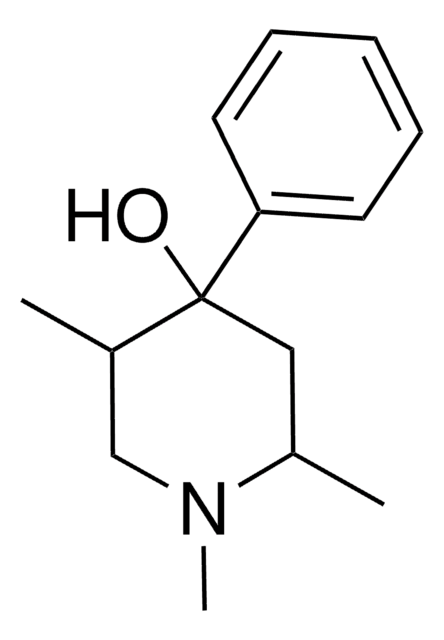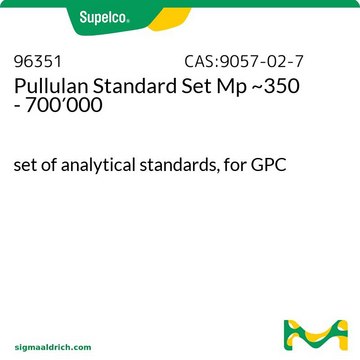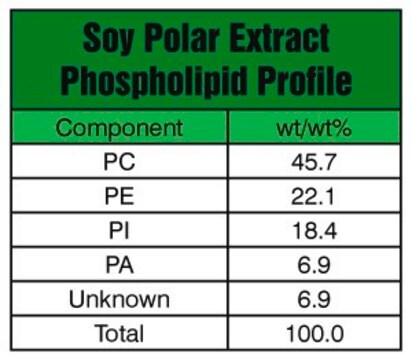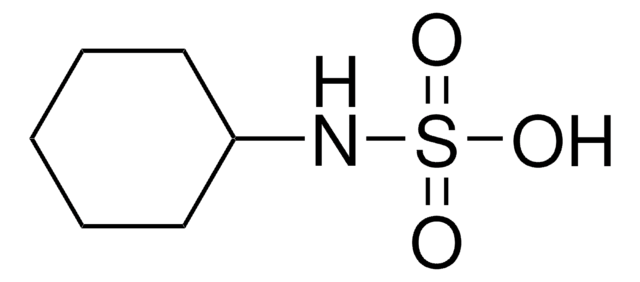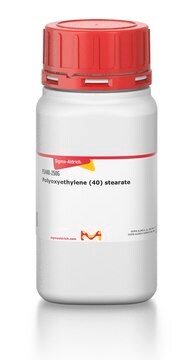769193
Eumulgin® B25
~100% active ingredients basis
Synonym(s):
Macrogol (25)-cetostearyl ether, Polyethylene glycol 1100 mono(hexadecyl/octadecyl) ether
Sign Into View Organizational & Contract Pricing
All Photos(1)
About This Item
Recommended Products
description
non-ionic
Quality Level
Assay
~100% active ingredients basis
form
crystals
impurities
≤1 mg/kg ethylene oxide
≤1.0% water
≤10 mg/kg dioxane
Looking for similar products? Visit Product Comparison Guide
General description
Eumulgin® B 25 is an oil-in-water emulsifier that is used for the production of ointments, creams, liquid emulsions, gels and other cosmetic formulations. It is supplied in the form of free-flowing, non-dusting micro-granules, and is an efficient protective colloid that can increase the stability of dispersed systems. This research grade product is intended for use in R&D only.
Legal Information
Eumulgin is a registered trademark of Cognis IP Management GmbH
Signal Word
Danger
Hazard Statements
Precautionary Statements
Hazard Classifications
Acute Tox. 4 Oral - Aquatic Acute 1 - Aquatic Chronic 2 - Eye Dam. 1 - Skin Irrit. 2
Storage Class Code
11 - Combustible Solids
WGK
WGK 2
Flash Point(F)
469.4 °F - closed cup
Flash Point(C)
243 °C - closed cup
Choose from one of the most recent versions:
Already Own This Product?
Find documentation for the products that you have recently purchased in the Document Library.
Customers Also Viewed
Muhammad Tayyab Ansari et al.
BioMed research international, 2015, 109563-109563 (2015-06-23)
Solid dispersions of artemether and polyethylene glycol 6000 (PEG6000) were prepared in ratio 12 : 88 (group-1). Self-emulsified solid dispersions of artemether were prepared by using polyethylene glycol 6000, Cremophor-A25, olive oil, Transcutol, and hydroxypropyl methylcellulose (HPMC) in ratio 12 : 75 : 5 : 4 : 2 : 2, respectively (group-2).
Antonio Leonardi et al.
International journal of pharmaceutics, 470(1-2), 133-140 (2014-05-06)
Addition of one or more surfactant agents is often necessary for the production of nanostructured lipid and polymeric systems. The removal of residual surfactants is a required step for technological and toxicological reasons, especially for peculiar applications, such as the
A Jelinek et al.
Experimental and toxicologic pathology : official journal of the Gesellschaft fur Toxikologische Pathologie, 50(4-6), 472-476 (1998-10-23)
Surface-active agents are components of many drugs and cosmetics. In order to examine their cytotoxic and membrane-toxic potential, various surfactants were examined in U937 cells using the tetrazolium reduction assay EZ4U, a modified XTT test, and the arachidonic acid release
Our team of scientists has experience in all areas of research including Life Science, Material Science, Chemical Synthesis, Chromatography, Analytical and many others.
Contact Technical Service

